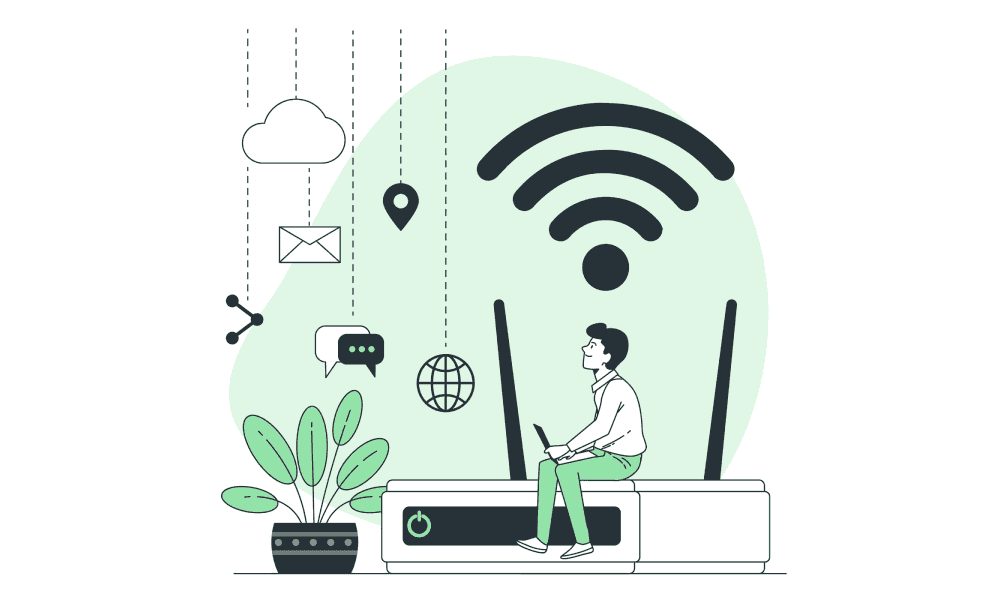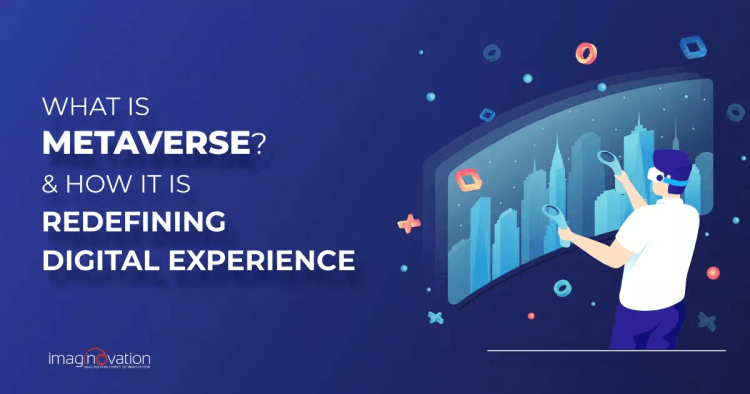Welcome to the edge of the digital frontier - the Metaverse. It's more than just a buzzword, it's a new digital reality that's redefining our online experiences.
Think the internet is immersive? The Metaverse takes it a step further, creating interactive, 3D virtual spaces where the lines between the physical and virtual blur.
Intrigued? Join us as we explore the Metaverse: what it is and how it's transforming our digital landscapes. Ready to take a glimpse into the future of digital experiences? Let's jump into the Metaverse together.
What is The Metaverse?
Metaverse is a broad concept. However, technology experts envision it as the successor to today's Internet.
Talking about the metaverse today seems like talking about the Internet back in the 70s and the 80s. As the Internet was still in its evolution stage then, it sparked speculation about what it would be like. Everyone was talking about it, but only a few knew about it and how it would work.
The Internet hasn’t turned out exactly as many people imagined then.
For metaverse, too – There is nothing we can legitimately identify as a metaverse – at least not yet.
While there seems to be hype around the term “metaverse,” it was an unknown term before 1992.
In 1992, the author Neal Stephenson first used this term in his sci-fi novel Snow Crash. In this novel, Stephenson referred to the metaverse as a digital world parallel to the real world.
In 2021, Mark Zuckerberg announced the rebranding of Facebook and its portfolio companies to ‘Meta.’ This was done to align his businesses to the goal of building the metaverse.
So, to define it, Metaverse would be a shared virtual environment where we will live, work, and socialize digitally.
We can think of the metaverse as an immersive and interconnected three-dimensional world powered by advanced technologies like VR, AR, AI, 5G, and Blockchain.
Persistent, infinite, self-sufficient, interoperable, and real-time are some of the features that further define the metaverse.
- Persistent because of its existence, irrespective of the user's physical location.
- Infinite because it can support countless users and VR worlds.
- Self-sustaining because the users can earn within the Metaverse and pay for what they use.
- Interoperable will allow users to seamlessly move their virtual assets from one Metaverse project to another.
- Real-time because it can facilitate the users to experience everything live.
Different Metaverse Use Cases and Benefits
We live in an era where people rely on virtual platforms and digital modes of communication to socialize and interact with each other.
Taking this digital experience a step higher, the Metaverse offers a wide range of real-world capabilities to users in a three-dimensional immersive world.
Here are the key advantages of the Metaverse:
1. Taking Up Remote Work Challenges
Workplaces of today are familiar with the concept of remote working.
Remote working brings the comfort and flexibility of working from anywhere. But employers complain that it lacks real-life interactions with employees. This creates a social disconnect. Moreover, people get tired of endless video meetings in such an environment.
Metaverse has the potential to counter the current challenges of remote work, whether it's video meetings fatigue, social disconnect, or time theft.

The metaverse promises to bring unimagined levels of social connection, mobility, and collaboration to this world of remote work.
Metaverse companies are building solutions for managers with virtual environments where they can meet their team members (their avatars), communicate with them, notice their body language, retain in-person interaction, and keep track of the entire team in a virtual office.
2. Excellent Tool for The Healthcare Professionals
Metaverse offers many promising benefits to the healthcare sector.
To begin with, it offers excellent prospects for improving the interaction between patients and healthcare professionals, irrespective of their geographical location. The virtual worlds in the metaverse can facilitate healthcare professionals to interact with the patient in real-time.
In addition, VR simulations in the metaverse can offer engaging and comprehensive learning experiences to medical students. For example, they can get an up-close view of the surgical procedure enhanced with tactile, haptic devices. Extended Reality tech can take them within the human body and show a 360-degree view of the patient’s disease.
Metaverse’s immersive visual capabilities also offer radiology imaging immense benefits. It is powered by better image visualization and provides an accurate disease diagnosis and close collaboration between physicians on 3-D images.
3. Innovative Opportunities For Businesses and Marketers
Millennials and Gen Z are already fans of some forms of the metaverse, such as Roblox games and technologies like VR. Keeping that in mind, businesses can opt for building a parallel metaverse attracting this generation.
From displaying virtual billboards to offering an immersive experience with ads and marketing initiatives, there's a lot that metaverses provide a business. For example, companies can create virtual events that users can interact with instead of simply viewing ads.
Companies can also offer assets or limited-edition items to customers that they can only collect in the metaverse.
Also Read: How to Successfully Build A Voice Chat App like Clubhouse?
4. Making Online Games Exciting and Fun
Metaverse has opened the way to a new category of online games with play-to-earn models. These metaverse games are decentralized. They allow gamers to purchase, sell, and trade in different game assets in the non-fungible token (NFTs).
Besides facilitating the gamers to reap economic returns from their gaming experiences, metaverse makes sure gamers enjoy the value of their autonomy and exercise ownership of their in-game assets and affairs.
In addition, the idea of avatars exploring the vast virtual space appeals to the players.
5. Providing The Experience of Virtual Tours

Metaverse has the potential to create unique virtual tours for travelers. It allows people to visit places virtually that they cannot visit physically. For example, metaverse will enable you to chat with your friend on top of the Eifel Tower or travel to the Egyptian pyramids from your home.
Combining the power of the Metaverse with technologies like AR and VR, an advanced virtual world is created that offers a first-person experience to the traveler.
Metaverse apps promise to make distant destinations accessible, especially for the elderly and people with limited mobility.
6. Offer an Entirely New Economy
Metaverse holds the potential to create a new digital economic model-new businesses, new jobs, and new roles.
Because of the open-source nature of the Metaverse, anyone can choose to build a project on top of the Metaverse ecosystem. In addition, people can join the metaverse ecosystem as general users and trade digital assets such as NFTs to earn money.
Metaverse has several applications. However, let’s discuss some of the prominent use cases of the Metaverse.
- Virtual office – Metaverse promises to build an MR (mixed reality) environment, complete with digital avatars for employers and employees. Businesses can create customizable solutions for teams to access virtual conferences, events, offices, and training.
- Blockchain use cases – Blockchain is one of the crucial technologies for building a decentralized metaverse. This tool is responsible for the large-scale adoption of metaverse across industries. In addition, it powers cryptocurrencies and serves as a distributed ledger in peer-to-peer transactions.
- Virtual tourism – VR and AR-powered metaverse elevate the imagination of the users. As a result, they can experience new locations in the metaverse as if they are present there in person.
- Virtual learning – Metaverse can revolutionize training and skills development, reducing the time needed to acquire new skills. Here, AI-driven digital coaches can train employees. In addition, every object (a training manual, process, or product) can be interactive in the metaverse, providing 3D visual displays.
- Real Estate Use case – Suppose you live in a country in the USA and wish to buy a house in another country. If you cannot travel to check the details of a new place personally, the realtors can offer you an option to visit your dream home virtually in the metaverse! You can walk through your future living room even before building the house and experience how you feel about it.
Key Emerging Technologies Powering The Metaverse
As the landscape of Metaverse is evolving, so is the nature of the content it offers – it is becoming all the more immersive and hyperconnected.
So, to drive the Metaverse forward and make its experience seamless for the users, you must first understand the technologies that power it.
There are many cutting-edge technologies, such as AR (Augmented Reality), VR (Virtual reality), blockchain, AI (Artificial Intelligence), IoT (Internet of Things), etc., that are set to power the digital world of the Metaverse.
Let’s look at some of them and understand why they are essential to building this fantasy world.
1. Artificial Intelligence
Whether it’s one’s business strategy planning, facial recognition, voice assistants like Alexa or Siri, or personalized marketing, there are many areas of our lives where we use AI. AI experts talk about the possibility of applying AI to the creation of immersive metaverses.
One of the prominent reasons for AI’s capability to make super-fast data calculations and predictions. Besides, when combined with machine learning (ML), it can highly improve algorithms, creating unique outputs.

For example, AI technology can analyze 2-D images and 3-D scans to create avatars that look more realistic and accurate, like a natural person. In addition, AI can also create different facial expressions, hairstyles, and clothes to enhance avatars (digital humans).
Another potential application for AI in the Metaverse is gaming. Here, AI can improve the actions and interactions of NPCs (nonplayer characters) in a 3D space. Unlike a human user, millions of players can use an AI-powered NPC simultaneously.
Moreover, AI can boost how we interact in Virtual reality by paying close attention to sensors measuring our bioelectrical and muscular patterns.
2. Augmented Reality and Virtual Reality
AR and VR technologies are the backbone of the Metaverse. They build engaging and immersive three-dimensional user experiences.
AR uses visual elements and graphical characters to enhance the real world. AR-based applications such as Pokemon GO facilitate users to look at their surroundings through attractive digital visuals. Anyone with a digital device and a smart camera can readily access AR apps.
VR resembles the concept of the Metaverse. It creates a full-fledged computer-generated digital world that users can explore using VR headsets or digital sensors.
As the technologies of AR and VR are becoming more mature, we are seeing metaverse experiences involving physical simulations. With the help of VR equipment, users can feel, hear and interact with people from other parts of the world.
The combination of both VR and AR technologies is likely to build a more realistic metaverse and attract massive investments from various companies.
3. Blockchain

Blockchain is another crucial technology contributing to the building and constant evolution of the Metaverse.
Blockchain is critical for building decentralized and transparent solutions that offer Metaverse functions such as digital proof of ownership, digital collectability, value transfer, and interoperability.
Besides, we know the risks related to hacks or malware that centralized ecosystems carry. Blockchain technology is sure to minimize such risks and make it possible to build a stable virtual ecosystem.
4. IoT
IoT is another in-demand technology for building the metaverse. As we all know, IoT bridges the gap between the physical world and the Internet, helping us send/receive data through sensors.
Metaverse, a highly immersive virtual environment, will be based on high-resolution input from the physical world. This requires enhanced IoT architectures.
Imagine visualizing a supply chain in the metaverse, complete with real-time data moving across locations. Or maybe a real-time weather sensor inside the Metaverse. All of this is possible with IoT.

IoT apps will be able to gather data and feed it to the metaverse to adjust more accurately to real-world conditions.
Another advantage of IoT is connecting the 3D world to an unlimited number of devices from the physical world, enabling real-time stimulations.
5. 3-D Reconstruction
3-D technology may not be new, but it has become more potent. The implication of applying 3-D reconstruction has increased across sectors, especially real-estate businesses.
After the covid-19 pandemic, businesses faced extended shutdowns and social distancing practices. In the real-estate sector, real-estate agencies adopted 3-D reconstruction technology to compensate for in-person visits by potential buyers and take them on virtual property tours.
3-D reconstruction facilitates the creation of a natural environment in which the users can navigate using their avatars. Furthermore, it helps digital users in the metaverse to check out the replica of a physical building. To further intensify and improve their experience, developers combine 3-D with 4K HD technology.
6. 5G

The availability of 5G networks is critical to a seamless metaverse experience. Earlier, users of virtual experiences often faced issues with their network because of slow rendering and data transfer speed. In addition, the Internet available wasn't fast enough.
However, with 5G being rolled out in many countries and made available at affordable rates, more users can experience the metaverse from their systems and devices without facing issues of lag in network speed.
Metaverse Projects to Look Out For in 2022
Several initiatives are steadily growing in the metaverse domain. In a short span, they have created a multi-billion-dollar industry. But first, let us look at the front runners and, most likely, the Metaverse powerhouses of the future.
1. The Sandbox
The Sandbox is a blockchain-based virtual world created by Pixowl Inc. It runs on NFTs and cryptocurrencies.
Here, gamers can build, own, explore, purchase, and monetize their gaming experiences in the Ethereum blockchain.
It has an NFT marketplace called 'The Sandbox Shop,' where players can trade in-game items such as land or wearables. In addition, the Sandbox has its own cryptocurrency - $SAND.
2. Decentraland
The Decentraland project was launched in 2016 and became one of the earliest inhabitants of the virtual world of Metaverse.
Today, Decentraland is a massive three-dimensional gaming universe. It boasts multiple applications and 300,000 plus active players.
It enables its users to acquire virtual real estate plots, host events, engage with other users and create content. In addition, the game incentivizes its players to develop, purchase, sell, and trade their NFTs.
3. Enjin
Enjin is another Metaverse project that’s built on the Ethereum blockchain.
Businesses can build decentralized NFT marketplaces based on their industry niche, integrate them, and trade them to earn money. It sets no bar on the project types, allowing developers to create a marketplace for all kinds of businesses.
4. Cryptovoxels
It is a 3D world organized around “Womps,” which are user-created worlds others can teleport into. Displaying NFTs in virtual art galleries is one of the widespread use cases of this platform.
5. Somnium Space
Somnium focuses on VR capabilities and includes breathtaking landscapes, scenery, and graphics.
Users can develop their property, games, and experiences here and build avatars that they can trade on the Somnium marketplace.
Somnium co-founder Artur Sychov strongly believes in the ultimate future of Virtual Reality worlds with an open and decentralized economy based on blockchain, where imagination is the only limit.
Embrace Digital Change with Imaginovation
Metaverse has a great deal of potential to grow. It is creating a whole new economy – you get many ways to earn money in the metaverse.
Right from buying and selling articles and collections of metaverse NFTs to creating a virtual property, there’s a lot that you can do. All you need to do is understand which project the users will like and which will attract new participants.
Contact us at Imagination if you're still unsure how to take the first step toward this digital change.
Imaginovation is an award-winning web and mobile app development company with vast experience crafting remarkable digital success stories for diverse companies.
Let's talk.
Ready to build an app, but not sure where to start?
We've got you covered. Click the button below to get started.





